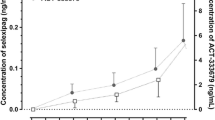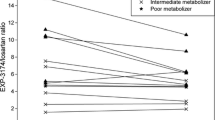Abstract
Objective
To clarify the involvement of cytochrome P450 (CYP) 3A4 in the metabolism of etizolam.
Methods
The effects of itraconazole, a potent and specific inhibitor of CYP3A4, on the single oral dose pharmacokinetics and pharmacodynamics of etizolam were examined. Twelve healthy male volunteers received itraconazole (200 mg/day) or placebo for 7 days in a double-blind randomized crossover manner, and on the 6th day they received a single oral 1-mg dose of etizolam. Blood samplings and evaluation of psychomotor function using the Digit Symbol Substitution Test and Stanford Sleepiness Scale were conducted up to 24 h after etizolam dosing. Plasma concentration of etizolam was measured by means of high-performance liquid chromatography.
Results
Itraconazole treatment significantly increased the total area under the plasma concentration–time curve (AUC; 213±106 ng⁃h/ml versus 326±166 ng⁃h/ml, P<0.001) and the elimination half-life (12.0±5.4 h versus 17.3±7.4 h, P<0.01) of etizolam. The 90% confidence interval of the itraconazole/placebo ratio of the total AUC was 1.38–1.68, indicating a significant effect of itraconazole. No significant change was induced by itraconazole in the two pharmacodynamic parameters.
Conclusion
The present study suggests that itraconazole inhibits the metabolism of etizolam, providing evidence that CYP3A4 is at least partly involved in etizolam metabolism.


Similar content being viewed by others
References
Ahonen J, Olkkola KT, Neuvonen PJ (1995) Effect of itraconazole and terbinafine on the pharmacokinetics and pharmacodynamics of midazolam in healthy volunteers. Br J Clin Pharmacol 40:270–272
Andersson T, Miners JO, Veronese ME, Birkett DJ (1994) Diazepam metabolism by human liver microsomes is mediated by both S-mephenytoin hydroxylase and CYP3A isoforms. Br J Clin Pharmacol 38:131–137
Bertilsson L, Henthorn TK, Sanz E, Tybring G, Sawe J, Villen T (1989) Importance of genetic factors in the regulation of diazepam metabolism: relationship to S-mephenytoin, but not debrisoquine, hydroxylation phenotype. Clin Pharmacol Ther 45:348–355
Casacchia M, Bolino F, Ecari U (1990) Etizolam in the treatment of generalized anxiety disorder: a double-blind study versus placebo. Curr Med Res Opin 12:215–223
Furukori H, Otani K, Yasui N, Kondo T, Kaneko S, Shimoyama R, Ohkubo T, Nagasaki T, Sugawara K (1998) Effect of carbamazepine on the single oral dose pharmacokinetics and pharmacodynamics of alprazolam. Neuropsychopharmacology 18:364–369
Garzone PD, Kroboth PD (1989) Pharmacokinetics of the newer benzodiazepines. Clin Pharmacokinet 16:337–364
Gorski JC, Jones DR, Hamman MA, Wrighton SA, Hall SD (1999) Biotransformation of alprazolam by members of the human cytochrome P4503A subfamily. Xenobiotica 29:931–944
Greenblatt DJ, Wright CE (1993) Clinical pharmacokinetics of alprazolam: therapeutic implications. Clin Pharmacokinet 24:453–471
Hikida K, Inoue Y, Nouchi E, Ohkura Y (1990) Determination of etizolam in human serum or plasma using automated column-switching high-performance liquid chromatography. Jpn J Clin Chem 19:354–359
Hoddes E, Zarcone V, Smythe H, Phillips R, Dement WC (1973) Quantification of sleepiness: a new approach. Psychophysiology 10:431–436
Kaplan SA, Jack ML, Alexander K, Weinfeld RE (1973) Pharmacokinetic profile of diazepam in man following single intravenous and oral and chronic oral administration. J Pharm Sci 62:1789–1796
Kato K, Yasui-Furukori N, Fukasawa T, Aoshima T, Suzuki A, Kanno M, Otani K (2003) Effects of itraconazole on the plasma kinetics of quazepam and its two active metabolites after a single oral dose of the drug. Ther Drug Monit 25:473–477
Kronbach T, Mathys D, Umeno M, Gonzalez FJ, Meyer UA (1989) Oxidation of midazolam and triazolam by human liver cytochrome P450 IIIA4. Mol Pharmacol 36:89–96
Luurila H, Olkkola KT, Neuvonen PJ (1996) Interaction between erythromycin and the benzodiazepines diazepam and flunitrazepam. Pharmacol Toxicol 78:117–122
Mitsubishi Pharma (2003) Unpublished data in package insert.
Olkkola KT, Beckman JT, Neuvonen PJ (1994) Midazolam should be avoided in patients receiving the systemic antimycotics ketoconazole or itraconazole. Clin Pharmacol Ther 55:481–485
Otani K, Yasui N, Kaneko S, Ohkubo T, Osanai T, Sugawara K, Hayashi K, Chiba K, Ishizaki T (1997) Effects of genetically determined S-mephenytoin 4-hydroxylation status and cigarette smoking on the single-dose pharmacokinetics of oral alprazolam. Neuropsychopharmacology 16:8-14
Otsuji Y, Okuyama N, Aoshima T, Fukasawa T, Kato K, Gerstenberg G, Miura M, Ohkubo T, Sugawara K, Otani K (2002) No effect of itraconazole on the single oral dose pharmacokinetics and pharmacodynamics of estazolam. Ther Drug Monit 24:375–378
Savoldi F, Somenzini G, Ecari U (1990) Etizolam versus placebo in the treatment of panic disorder with agoraphobia: a double-blind study. Curr Med Res Opi 12:185–190
Steinijans VW, Hartmann M, Huber R, Radtke HW (1991) Lack of pharmacokinetic interaction as an equivalence problem. Int J Clin Pharmacol Ther Toxicol 29:323–328
Tsumagari T, Nakajima A, Fukuda T, Shuto S, Kenjo T, Morimoto Y, Takigawa Y (1978) Pharmacological properties of 6-(o-chrorophenyl)-8-ethyl-1-methyl-4H-s-triazolo[3,4-c]thieno[2,3-e] [1,4]diazepine (Y-7131), a new anti-anxiety drug. Arzneimittelforschung 28:1158–1178
Varhe A, Olkkola KT, Neuvonen PJ (1994) Oral triazolam is potentially hazardous to patients receiving systemic antimycotics ketoconazole or itraconazole. Clin Pharmacol Ther 56:601–607
Venkatakrishnan K, von Moltke LL, Greenblatt DJ (2000) Effects of the antifungal agents on oxidative drug metabolism. Clin Pharmacokinet 38:111–180
Wechsler D (1981) Wechsler adult intelligence scale, revised. Harcourt Brace Jovanovich, New York
Yasui N, Otani K, Kaneko S, Ohkubo T, Osanai T, Sugawara K, Chiba K, Ishizaki T (1996) A kinetic and dynamic study of oral alprazolam with and without erythromycin in humans: in vivo evidence for the involvement of CYP3A4 in alprazolam metabolism. Clin Pharmacol Ther 59:514–519
Yasui N, Kondo T, Otani K, Furukori H, Kaneko S, Ohkubo T, Nagasaki T, Sugawara K (1998) Effect of itraconazole on the single oral dose pharmacokinetics and pharmacodynamics of alprazolam. Psychopharmacology 139:269–273
Author information
Authors and Affiliations
Corresponding author
Rights and permissions
About this article
Cite this article
Araki, K., Yasui-Furukori, N., Fukasawa, T. et al. Inhibition of the metabolism of etizolam by itraconazole in humans: evidence for the involvement of CYP3A4 in etizolam metabolism. Eur J Clin Pharmacol 60, 427–430 (2004). https://doi.org/10.1007/s00228-004-0789-1
Received:
Accepted:
Published:
Issue Date:
DOI: https://doi.org/10.1007/s00228-004-0789-1




